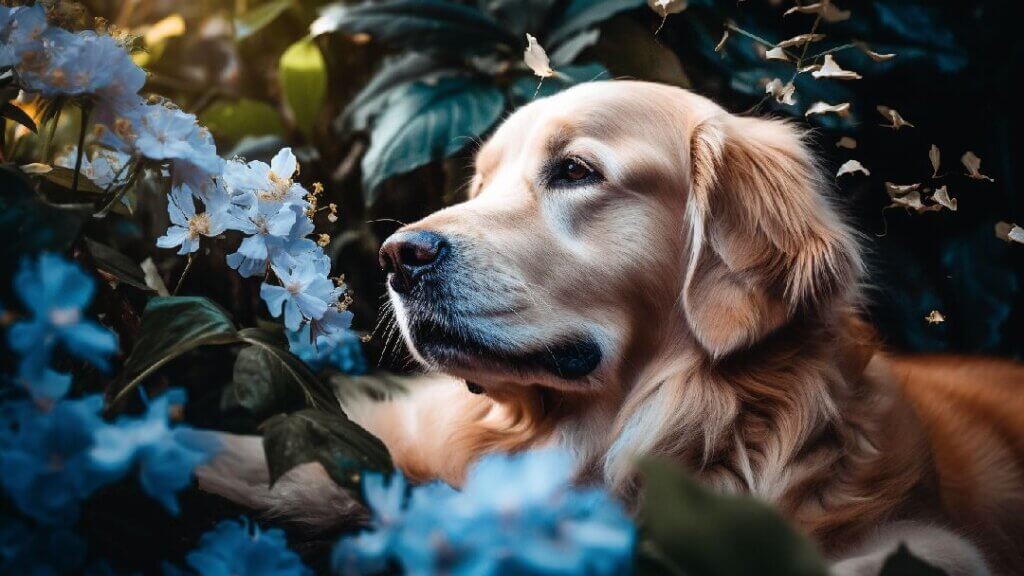Poisonous plants pose a silent threat to our beloved canine companions, lurking in our gardens and homes with potential harm to our four-legged friends.
Let’s embark on a journey to unveil the hidden dangers within our green spaces, shedding light on common toxic plants for dogs that could jeopardize our furry family members’ well-being and learn ways of preventing plant toxicity in dogs.
Identifying Toxic Plants
Identifying toxic plants is the first crucial step in ensuring your dog’s safety. Familiarity with the following common poisonous flora will empower you to create a secure haven for your pet:
As responsible pet owners, understanding the risks associated with toxic flora is paramount in creating a safe environment for our dogs.
1. Oleander (Nerium oleander)
With its vibrant clusters of flowers, Oleander is a common ornamental shrub. It thrives in warm climates, boasting dark green, leathery leaves.
Effects when Ingested: Ingesting any part of the oleander plant can lead to severe gastrointestinal issues, heart abnormalities, and, in extreme cases, fatalities.
2. Azalea (Rhododendron spp.)
Azaleas, cherished for their colorful blooms, are popular in gardens. These shrubs have leathery leaves and produce clusters of flowers in various hues.
Effects when Ingested: Consumption may result in vomiting, diarrhea, and potentially fatal cardiovascular complications.
3. Autumn Crocus (Colchicum autumnale)
Despite its appealing name, the autumn crocus is highly toxic. It produces delicate, crocus-like flowers in shades of purple and white.
Effects when Ingested: Ingestion can lead to severe gastrointestinal distress, kidney and liver damage, and even organ failure.
4. Sago Palm (Cycas revoluta)
Often used in landscaping, the Sago Palm resembles a small, sturdy palm tree with feather-like fronds.
Effects when Ingested: Ingesting any part can cause vomiting, seizures, and liver failure, posing a substantial threat to dogs.
5. Castor Bean Plant (Ricinus communis)
Known for its large, spiky green seed pods, the castor bean plant is an ornamental shrub or small tree.
Effects when Ingested: The seeds contain ricin, a potent toxin that can lead to severe abdominal pain, vomiting, and, in extreme cases, death.
6. Oleander (Nerium oleander)
Oleander, with its vibrant clusters of flowers, is a common ornamental shrub. It thrives in warm climates, boasting dark green, leathery leaves.
Effects when Ingested: Ingesting any part of the oleander plant can lead to severe gastrointestinal issues, heart abnormalities, and, in extreme cases, fatalities.
7. Autumn Crocus (Colchicum autumnale)
Despite its appealing name, the autumn crocus is highly toxic. It produces delicate, crocus-like flowers in shades of purple and white.
Effects when Ingested: Ingestion can lead to severe gastrointestinal distress, kidney and liver damage, and even organ failure.
8. Sago Palm (Cycas revoluta)
Often used in landscaping, the Sago Palm resembles a small, sturdy palm tree with feather-like fronds.
Effects when Ingested: Ingesting any part can cause vomiting, seizures, and liver failure, posing a substantial threat to dogs.
9. Castor Bean Plant (Ricinus communis)
Known for its large, spiky green seed pods, the castor bean plant is an ornamental shrub or small tree.
Effects when Ingested: The seeds contain ricin, a potent toxin that can lead to severe abdominal pain, vomiting, and, in extreme cases, death.

Dog-Friendly Shrubs
Let’s delve into the realm of dog-friendly shrubs, seeking to create a haven of safety for our beloved four-legged friends.
Selecting dog-friendly shrubs is a thoughtful and proactive measure in fostering a garden that not only blooms with beauty but is also safe for your pets.
- Lavender (Lavandula)
Known for its aromatic charm, lavender is pleasing to humans and safe for dogs. This fragrant shrub adds a touch of tranquility to your garden without posing any harm to your furry friends.
- Bluebeard (Caryopteris)
With its vibrant blue flowers, Bluebeard is visually appealing and a non-toxic option for your canine companions. This deciduous shrub thrives in various climates and provides a safe space for your pets to explore.
- Rose (Rosa)
The classic rose, symbolizing love and beauty, is surprisingly safe for dogs. Opting for dog-friendly rose varieties ensures your garden remains a haven without compromising elegance.
- Forsythia (Forsythia spp.)
Known for its early spring blossoms, forsythia is a dog-friendly shrub that brightens your garden without posing any threat. Its cheerful yellow flowers are welcome and bring joy without endangering your pets.
- Barberry (Berberis)
With its colorful foliage, Barberry is a hardy shrub that adds visual interest to your garden. It’s a safe choice for dogs, allowing you to create a diverse and secure landscape.

Cultivating a Safe Garden Environment
Discover essential tips to nurture flora and fauna harmoniously in this green haven.
Fence Off Hazardous Areas
While incorporating dog-friendly shrubs is a positive step, creating physical barriers around potentially harmful plants is essential. Fencing off certain areas ensures your pets can roam freely without stumbling upon toxic threats.
Educate Yourself
Continual education is key to maintaining a safe garden environment. Stay informed about the plants within your space and their potential effects on dogs. Regularly check for updates on pet-safe gardening practices to adapt and evolve your green space.
Consult with Veterinarians
If uncertainties persist about the safety of certain shrubs, consulting with a veterinarian can provide valuable insights. Veterinarians can offer tailored advice based on your specific garden layout and the habits of your furry companions.
Real-Life Stories: Dog Poisoning From Plants
Real-life stories of dog poisoning from plants underscore the urgency of understanding and addressing the risks that certain flora poses to our furry friends.
Tale 1: Lily Lament
One heart-wrenching story revolves around Lily, a spirited Labrador Retriever whose owner adorned their garden with vibrant lilies. Unbeknownst to them, lilies are among the most toxic plants for dogs.
Lily’s playful nature led her to explore the garden, and a few nibbles on the lily plants resulted in a life-threatening emergency. Swift veterinary intervention saved Lily, but the incident left an indelible mark on her owner, highlighting the importance of plant awareness.
Tale 2: Azalea Anguish
In another tragic incident, a family discovered the peril of azaleas, popular flowering shrubs in many gardens. Their curious pup, Max, ingested azalea leaves during a romp in the backyard.
Within hours, Max exhibited symptoms of toxicity, including vomiting and lethargy. The family rushed him to the vet, where a prompt diagnosis and treatment saved Max’s life.
This harrowing experience underscores the need for vigilance even with commonly cultivated plants.
Safeguarding Your Pup: Tips for a Pet-Safe Garden
Creating a pet-safe garden goes beyond avoiding toxic plants. Consider these additional tips to enhance the well-being of your furry friend:
- Provide a Shaded Retreat
Ensure your garden offers shaded areas where your dog can retreat during hot weather. This not only protects them from the sun but also encourages outdoor enjoyment.
- Safe Digging Zones
Designate specific areas for your dog to dig, satisfying their instincts without damaging your garden. Fill these zones with loose soil or sand for a dog-friendly digging experience.
- Water Source
Always provide a clean and accessible water source in the garden. Hydration is crucial, especially during warmer months.
- Comfortable Resting Spots
Place cozy beds or blankets in shaded areas for your dog to rest comfortably. Having designated spots can keep them from lounging on potentially harmful plants.
- Regular Vet Check-ups
Schedule regular veterinary check-ups to ensure your dog’s overall health. Discuss any concerns about their behavior or potential exposure to toxic plants with your veterinarian.

Conclusion
The tales of dog poisoning from plants serve as poignant reminders of the hidden dangers in our gardens. The heart-wrenching experiences of pet owners underscore the critical need for awareness and proactive measures.
By embracing preventive strategies, we can cultivate a garden that not only blooms with beauty but also ensures the well-being of our cherished canine companions and prevents plant toxicity in dogs.

FAQs
Will dogs stay away from toxic plants?
Dogs may not inherently avoid toxic plants. Training them, creating physical barriers, and choosing dog-friendly landscaping is crucial to ensure their safety.
How long does it take for plant poisoning to show in dogs?
Symptoms can appear within hours to days. Swift action is vital; contact your vet promptly if you observe any abnormal behavior in your dog.
Can all toxic plants be fatal to dogs?
While some plants can be lethal, many cause varying degrees of toxicity. However, any suspected ingestion should be treated seriously, and immediate veterinary assistance should be sought.
Are there seasonal considerations for plant toxicity in dogs?
Some plants pose higher risks during specific seasons or stages of growth. Stay vigilant, especially during spring when gardens flourish and plants bloom.
Can plant toxicity affect all dog breeds equally?
Sensitivity varies among breeds, and individual dogs may react differently. Additionally, puppies and older dogs may be more vulnerable. Understanding your dog’s breed and age is crucial for effective prevention.






0 Comments